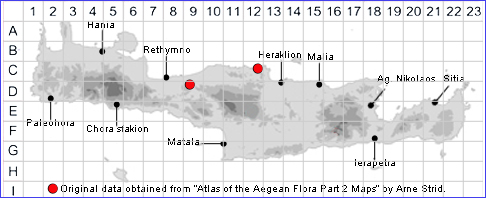
SPECIES DESCRIPTION
EUPHORBIA TAURINENSIS
Family and Genus:- See- EUPHORBIACEAE/Subgen. ESULA/Sect.
Common Names:- None
Homotypic Synonyms:- Esula taurinensis, Tithymalus taurinensis.
Meaning:- Euphorbia (L) For Euphorbus, physician to the King of Mauritania.
Taurinensis (L) From the Crimea.
General description:- Glabrous annual.
Stems:-
1) Up to 15 cm, simple or with 2 branches from the base, with up to 6 axillary rays.
Leaves:-
1) Cauline, 20-30 x 3·5-5 mm, shortly petiolate, linear-oblanceolate, entire.
2) Ray-leaves, like the upper cauline.
3) Raylet-leaves, somewhat rhombic-trullate, acute, subentire.
Flowers:-
1) Rays, (3-)4(-5), often much-branched.
2) Glands, yellow, with 2 pink horns.
Fruit:-
1) Capsule, 2.0-2.3 mm, with rounded valves, smooth or minutely granulate.
2) Seeds, 1.5-1.8 mm, ellipsoid to broadly oblong, reticulate-pitted, greyish-white;
caruncle sublateral, conical.
Key features:-
1) Raylet-leaves, obliquely rhombic-trullate to transversely ovate.
2) Seeds, pitted or sulcate or both.
Habitat:- Gravelly coastal habitats, dry open shrubby vegetation , coniferous
woodland, deciduous scrub, field margins. 0-900 m.
Distribution:- Throughout mainland Greece and Peloponnisos but less common in
the west. - Widespread in the Mediterranean region and SW Asia. Rare on Crete,
currently known from only two locations.
Flowering time:- Mar-June.
Photos by:- Kind permission of Saxifraga - Free Nature Images & Wiki-Commons
